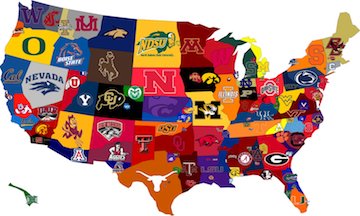Lilly Donahue | Indiana University
If you’re anything like me, you probably find yourself constantly questioning why Maryland and Rutgers are in the Big Ten. Trust me, you’re not alone. Big Ten Commissioner Jim Delaney says the two teams were added to open up the DC and NYC sports markets, which I can understand for Maryland, but I’m like 85% sure New Yorkers share that same national hatred for Rutgers that every American should have. But the Big Ten isn’t the only conference whose members don’t make sense geographically. Louisville, Pitt, and Syracuse are odd additions to the Atlantic Coastal Conference, West Virginia is the odd man out in the Big 12, and Texas A&M makes little sense in a conference for southeastern schools. Since these Power 5 commissioners obviously didn’t employ a cartographer when creating their leagues, I decided to do them a favor and restructure the Power 5 based on geography. The central location for each school is decided by when the conference headquarters is located, and then the driving time from the HQ to each school was used to re-sort the conference. The geographic realignment returns some of CFB’s best rivalries to the center stage (@Texas-Texas A&M). Take a look! New teams are italicized.
Big 10
HQ: Rosemont, IL (basically Chicago)
- Illinois
- Northwestern
- Indiana
- Purdue
- Notre Dame
- Iowa
- Iowa State
- Louisville
- Michigan
- Michigan State
- Minnesota
- Ohio State
- Nebraska
- Wisconsin
The Big 10’s restructuring kept many classic teams in the conference, and booted out the two ugly ducklings in Maryland and Rutgers. Penn State also made an exit to the ACC, whose headquarters are closer to State College. The addition of Notre Dame, Iowa State, and Louisville is not only great for basketball, but also a pretty big boost for football. The conference keeps all its most famous rivalries, and adds a new one in Iowa-Iowa State. Notre Dame and Louisville would also be potential rivals to schools like IU and Purdue. In any case, this conference is strengthened by the changes!
Big 12
HQ: Irving, TX (basically Dallas)
- Arkansas
- Arizona
- Colorado
- Kansas
- Kansas State
- Oklahoma
- Oklahoma State
- Texas
- Texas A&M
- Baylor
- TCU
- Texas Tech
The Big 12 dumps West Virginia and gets its numbers up to 12 teams, which finally makes sense for a conference called the Big 12. The addition of Arkansas, Arizona, Colorado, and Texas A&M gives the Big 12 a major boost, and brings back one of college football’s most beloved rivalries in Texas-Texas A&M. The conference is especially strong on the basketball court, particularly due to the addition of Arizona.
SEC
HQ: Birmingham, AL
- Alabama
- Auburn
- Florida
- Florida State
- Miami
- Georgia
- Georgia Tech
- Kentucky
- LSU
- Ole Miss
- Mississippi State
- Tennessee
- Vanderbilt
- Missouri
If any conference won out in the restructuring process, it’s the SEC. The conference is already the strongest in football, and they definitely secured the spot at the top with the addition of FSU, Miami, and Georgia Tech. While the conference only had three additions, the teams it gained are excellent, especially for the Florida market. The SEC lost 3 teams as well, but all three (Arkansas, Texas A&M, and South Carolina) were subpar conference players that are fairly easy to replace. The SEC benefited more from redistricting than a candidate in a gerrymandered district!
PAC-12
HQ: San Francisco, CA
- Arizona State
- Cal
- USC
- UCLA
- Stanford
- Oregon
- Oregon State
- Utah
- Washington
- Washington State
The PAC-12 was definitely the loser of the changes, since they were the only conference to not add any new schools. They lost Colorado and Arizona to the Big 12, but the conference itself is still solid. Football wise, they still are mediocre, but they are one of the stronger basketball conferences despite their losses.
ACC
HQ: Greensboro, NC
- Maryland
- Boston College
- Rutgers
- Duke
- NC State
- Wake Forest
- UNC
- Penn State
- Pitt
- South Carolina
- Clemson
- Virginia
- Virginia Tech
- West Virginia
The ACC also did pretty well, gaining Maryland, Penn State, West Virginia, South Carolina, and Rutgers (although that’s more of a loss than a gain). The conference itself is already strong, especially at basketball, and the addition of Maryland bolsters the basketball strength. The conference did lose Florida State, Miami, Georgia Tech, Louisville, and Notre Dame (basketball). These are major losses, especially in football, but the conference does still boast the most recent natty champ in Clemson.
Overall, I’d say the SEC won the restructuring, then the ACC, Big 10, Big 12, and Pac 12. Let me know what you think of the changes in the comments of on Twitter @LillyD11915 !








